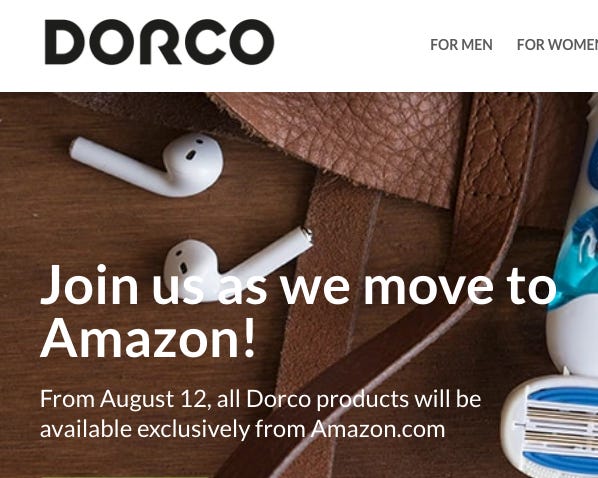Razor Blade Wars Part II: Amazon and Walmart's Role in Shaving
The FTC blocked the Harry's takeover. Walmart made moves in response. And Amazon signed an exclusive deal with Dorco razors, degrading their quality.
Welcome to BIG, a newsletter on the politics of monopoly power. If you’d like to sign up to receive issues over email, you can do so here.
I didn’t realize there was so much drama in the shaving market. Last week, I wrote up how the Federal Trade Commission blocking a takeover of Harry’s helped undermine Proctor & Gamble’s market power in the wet shave space.
I got two fascinating notes about this market from readers, each hitting a different angle. The first was on the role of Walmart in controlling and using shelf space as leverage to get exclusive deals, which is generally not widely understood. Harry’s played a useful role in Walmart’s negotiations with Proctor & Gamble, as this reader notes.
I was excited to see your writeup on the blocked Harry's merger and the aftermath. I thought I would share with you some details of Harry's relationship with WalMart and how WalMart has leveraged its position as the biggest retailer with these razor suppliers. Sometimes the results are good for the customer and sometimes bad.
As you pointed out the wet shave space in retail was dominated by Gillette, and Schick to a lesser extent, with no midway point between their products and lower quality disposable razors. This was when WalMart brought Harry's to their sales floor in a big way. They gave them a 6-month endcap and leadoff position in the shave aisle from action alley.
WalMart typically allows feature space like an endcap in one-month increments switching out displays frequently. Giving an upstart this space for 6 consecutive months was a big deal. Harry's also took over Gillette's "leadoff" position on the shave aisle pushing Gillette further down the aisle. What this meant as a shopper at WalMart was if you were walking down the main aisle of the store near the Health and Beauty aid section you would see a huge Harry's semi-permanent endcap feature. Then, if you turned into the aisle, Harry's and their upscale signage would be the first razor brand you would run into. The result was after several months Harry's 4ct refill cartridge was the #1 selling item in Wet Shave. It was a definite shot across the bow of Gillette and they were left scrambling.
By this time Harry's had also rolled out in Target with plans in Drug and Grocery chains. Their plan seemed to be to gain as much distribution as possible and then start fielding offers. Their next step was to roll out Flamingo, their women's razor brand, in store. WalMart pushed Harry's to make Flamingo a WalMart exclusive brand. Retailers love exclusives as they force brand loyal customers into their stores. Harry's stood their ground and moved forward with the launch of Flamingo in Target as planned and this caused WalMart to decide not to distribute Flamingo at all.
What happened next showed how much Harry's had shaken up the razor market and how this benefitted WalMart. Instead of continuing the Harry's endcap for another 6 months as planned, WalMart pulled it in favor of another long term endcap for a new brand called Joy. Joy was a new mid-price point women's razor that was exclusive to WalMart and the supplier was....you guessed it - P&G. A few months later Harry's would be moved to the end of the shave aisle by WalMart with Gillette returning to their leadoff position followed by Schick and then Harry's. 3 years later Dollar Shave Club has launched in WalMart and been wedged in front of Harry's on the aisle and Flamingo is still not available in WalMart despite wide distribution in Target and many Drug and Grocery chains. The brand's popularity may finally force that to change.
As a side note, I was very surprised at the time when the Harry's/Edgewell merger was blocked despite the frenzy of approved tech mergers around that same time. Then I thought about the men who make these decisions not understanding the internet, but remembering how much razors used to cost and putting their foot down for once. Finally, something their old clean-shaven faces could understand.
So that’s Walmart, Target, and most retail distribution. There’s also online distribution, and another reader mentioned wrote to let me know how that space has consolidated. Harry’s makes its own razors. But Dollar Shave Club, which was another competitor that emerged at roughly the same time to distribute razors online, did not. Dollar Shave Club bought razors from Dorco. In 2016, Unilever bought Dollar Shave Club, which probably reduces Dorco’s business dramatically, as one of its main distribution partners got absorbed by a larger entity.
Dorco responded by signing a deal in 2019 with Amazon to be an exclusive distributor.
Be aware that there was another competitor- Dorco, the company behind DSC razors, used to sell them directly and online. I bought them from Amazon since they worked as well as high end Gilettes but at a lower cost. Then they signed an exclusive online distribution deal with Amazon. They redesigned the razor and it went from great to garbage. Into the hands of a new monopoly. Read the reviews about what happened in Q4 2019.
The reviews are here. It looks like the quality of the product declined.
So there we go. Razor blades are big business, and also a market segment where the effects of mergers and competition on quality and price is obvious.



Wear a beard.
Use an electric shaver.